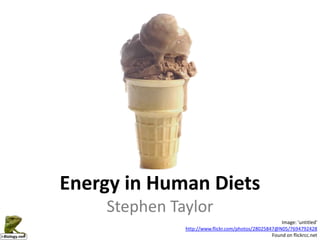
A2 Energy in Human Diets
- 1. Energy in Human Diets Stephen Taylor Image: 'untitled' http://www.flickr.com/photos/28025847@N05/7694792428 Found on flickrcc.net
- 2. Assessment Statements Obj. A2.1 Compare the energy content per 100g of carbohydrate, fat and protein. 3 A2.2 Compare the main dietary sources of energy in different ethnic groups. 3 Explain the possible health consequences of diets rich in carbohydrates, A2.3 3 fats and proteins. (Explain consequences of excess of each separately). A2.4 Outline the function of the appetite control centre in the brain. 2 Calculate the body mass index (BMI) of a person from their weight and A2.5 2 height. Distinguish, using the BMI, between being underweight, normal weight, A2.6 2 overweight and obese. Outline the reasons for increasing rates of clinical obesity in some countries, including the availability of cheap high-energy foods, large A2.7 2 portion sizes, increasing use of vehicles for transport, and a change from active to sedentary occupations. A2.8 Outline the consequences of anorexia nervosa. 2 Command terms: http://i-biology.net/ibdpbio/command-terms/ Assessment statements from: Online IB Biology Subject Guide
- 3. What is food energy and how can it be measured? Food energy: from carbohydrates, proteins, fats. Units: food calories (kcal) or kilojoules (1kcal = 4.18kJ) 1 food Calorie = 1000 calories (1 calorie = the energy required to raise the temperature of 1g water by 1oC.) SI unit: kilojoules 1 food Calorie = 4.1kJ (kilojoules) As humans are autotrophs, we take energy from food, in form of carbohydrates, lipids or proteins. Image: 'Big Mac' http://www.flickr.com/photos/7236030@N03/2741811882 http://nutritiondata.self.com/facts/fast-foods-generic/8053/2 Found on flickrcc.net
- 4. Compare carbohydrate, fats and proteins in terms of energy storage. Energy /100g Carbohydrates Fats Proteins kJ 1,760 4,000 1,720 kcal (Calories) 421 956 411 Image: 'Big Mac' http://www.flickr.com/photos/7236030@N03/2741811882 http://nutritiondata.self.com/facts/fast-foods-generic/8053/2 Found on flickrcc.net
- 5. Compare carbohydrate, fats and proteins in terms of energy storage. Energy /100g Carbohydrates Fats Proteins kJ 1,760 4,000 1,720 kcal (Calories) 421 956 411 Carbohydrates are broken down into monosaccharides (sugars) during digestion, absorbed into the blood and assimilated into cells for respiration. Foods rich in sugars or simple (processed) carbohydrates give a quick release of blood sugar. More complex carbohydrates give a slower, more sustained release of sugars to the blood. http://nutritiondata.self.com/facts/fast-foods-generic/8053/2
- 6. Compare carbohydrate, fats and proteins in terms of energy storage. Energy /100g Carbohydrates Fats Proteins kJ 1,760 4,000 1,720 kcal (Calories) 421 956 411 Fats are a highly efficient store of energy as they contain long- chain fatty acids, made with many carbon atoms. During the link reaction of respiration, pairs of carbon atoms are transported into the Krebs cycle and used to produce ATP. So… long chains + lots of carbons = lots of energy storage. They are easier to build than they are to break down, though! http://nutritiondata.self.com/facts/fast-foods-generic/8053/2 http://en.wikipedia.org/wiki/Triglyceride
- 7. Compare carbohydrate, fats and proteins in terms of energy storage. Energy /100g Carbohydrates Fats Proteins kJ 1,760 4,000 1,720 kcal (Calories) 421 956 411 Proteins are long-chain polymers of amino acids and contain carbon atoms. They can be used for cell respiration, though they are harder to metabolise than lipids or carbohydrates. http://nutritiondata.self.com/facts/fast-foods-generic/8053/2 http://en.wikipedia.org/wiki/Protein_(nutrient)
- 8. Reading Food Labels Calculate the % Calories from fat in this burger. Calculate the % fat by weight in the burger. http://nutritiondata.self.com/facts/fast-foods-generic/8053/2
- 9. Reading Food Labels Calculate the % Calories from fat in this burger. (295/563) X 100 = 52.4% Calculate the % fat by weight in the burger. http://nutritiondata.self.com/facts/fast-foods-generic/8053/2
- 10. Reading Food Labels Calculate the % Calories from fat in this burger. (295/563) X 100 = 52.4% Calculate the % fat by weight in the burger. (33/219) X 100 = 15.1% Why “99% Fat Free” could be a lie… http://nutritiondata.self.com/facts/fast-foods-generic/8053/2 http://www.youtube.com/watch?v=yd9XnyNGXGs
- 12. Staple diets vary by geographical region and culture Food staples are the main source of dietary energy for a population. http://click4biology.info/c4b/a/A2.htm Geographical Region/ Culture Main food energy source Continental Europeans, USA UK & Northern Europe Central Africa & Brazil Americas & Africa Asia Eskimo Tribes Isolated Island Populations
- 26. Exercise & Energy “How many calories are in your favorite foods? How much exercise would you have to do to burn off these calories? What is the relationship between calories and weight? Explore these issues by choosing diet and exercise and keeping an eye on your weight.” PhET Lab: Eating & Exercise http://phet.colorado.edu/en/simulation/eating-and-exercise You can try Wolfram | Alpha too. What does it say about your favourite forms of exercise?
- 51. Image: 'untitled' http://www.flickr.com/photos/28025847@N05/7694792428 Found on flickrcc.net @IBiologyStephen Please consider a donation to charity via Biology4Good. Click here for more information about Biology4Good charity donations. This is a Creative Commons presentation. It may be linked and embedded but not sold or re-hosted.
